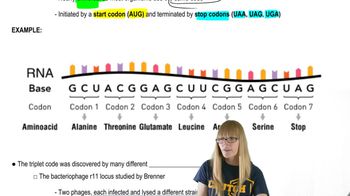Here are the essential concepts you must grasp in order to answer the question correctly.
tRNA and Anticodon-Codon Pairing
Transfer RNA (tRNA) is a type of RNA that helps decode a messenger RNA (mRNA) sequence into a protein. Each tRNA molecule has an anticodon, a set of three nucleotides that pairs with a complementary codon on the mRNA. In this case, the CGA anticodon would pair with the corresponding codon on the mRNA, which is determined by the base pairing rules (A-U and C-G).
Recommended video:
Codon and Genetic Code
A codon is a sequence of three nucleotides in mRNA that specifies a particular amino acid or a stop signal during protein synthesis. The genetic code is universal and consists of 64 codons that correspond to 20 amino acids. Understanding how codons are read is essential for translating genetic information into functional proteins.
Recommended video:
Hyperchromic Shift and RNA Secondary Structure
A hyperchromic shift refers to an increase in absorbance of UV light by nucleic acids, indicating changes in their structure, often due to denaturation or alterations in secondary structure. In RNA, secondary structures such as hairpins and loops can form, influencing its function and interaction with other molecules. Recognizing these structural features is important for understanding RNA behavior in biological processes.
Recommended video:
 Verified step by step guidance
Verified step by step guidance Verified video answer for a similar problem:
Verified video answer for a similar problem: